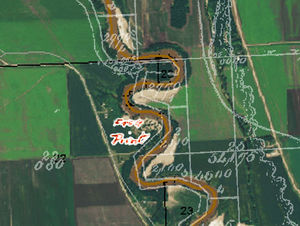Frog Point, North Dakota
Frog Point was a rendezvous location, Hudson Bay trading post, and stagecoach stop on the Red River trail. Flooding eventually caused its demise, after a short time being named "Belmont".
Location
Frog Point was approximately equidistant between Pembina and Georgetown[1] on the west bank of the Red River. It was situated on the southeast quarter of the northeast quarter of section 22, township 148, range 49. The Minnesota survey plat done in 1875 does not include surveys of the North Dakota side; however, a helpful surveyor or researcher had written in "Frog Point" in light pencil at the correct location.
The land was owned by Walter J S Traill, who worked for the Hudson Bay company and supervised the Georgetown trading post until he was able to take over the Frog Point post in 1871.
Currently, there is a small park on the spot, called "Belmont Park" in some cases, after the last town name which occupied this spot. For a time, low river levels made Frog Point the furthest upstream port for riverboats. High river levels in later years flooded the town, and the townsite was eventually abandoned.
The Federal Writer's Project book, "North Dakota: A Guide to the Northern Prairie State", describes Frog Point as such:
Right on this road is BELMONT, 11.5m, a ghost town which in the 1870's was a booming river port known as Frog Point. It was named by Capt. Sam Painter, one of the first Red River pilots, on an early trip down the river, probably in 1860. Finding the shores almost covered in frogs, he is said to have erected a rude sign reading "Frog Point," and through the rise and fall of the town which grew up there the name remained. In 1871 the Hudson's Bay Co. established a trading post on the point. A year later, because of the fall of the river, Frog Point became head of navigation, and in short order was a rendezvous for boatmen, trappers, hunters, teamsters, and drifters, all living in tents or hastily constructed buildings. Teamsters hauling freight overland from the S. in their heavy, eight-horse, high wheeled "jumpers", and trappers and Indians with their catches, here boarded the Hudson's Bay Co. steamer International, and James J Hill's Selkirk. The town, cut from the woods on the bank of the Red, and towered over by tall oaks, became a wilderness metropolis, and its reputation spread to Europe. In England it was believed by many to be a city of broad avenues and tall spires, second in size only to Liverpool, and filled with the hum of industry. Foreign visitors, traveling to Fort Garry, looked eagerly for this Red River capital, and even their disillusionment on seeing the little backwoods city could not dim its reputation. In is streets rough, rugged, heavy-booted woodsmen, rivermen, and trappers thundered up and down the wooden walks, and many a citizen was hastily dispatched by their 44's. Heavy-jowled saloonkeepers, slim-fingered sleek gamblers, and gay dance-hall girls were all part of the mushroom town.
Nature brought downfall to the Point as quickly as she had elevated it to importance. The river fell lower still and Frog Point lost its position as head of navigation. Many of its inhabitants departed as swiftly as they had come. Fire wiped out a number of buildings which were never rebuilt. Trade dwindled and storekeepers shut up shop. Some 20 years later, with the river level again up, the town revived as a grain-shipping center, but the flood of 1897 ruined grain elevators and their contents, and within a short time the bustle of town again faded into the past. Today the Hudson's Bay Co. Building, which houses a farm implement shop, is all that remains of the early affluence. The present population of the hamlet, which is not even an organized village, is 33.
References
- ↑ History of Dakota Territory, http://www.archive.org/stream/historyofdakotaterr01king/historyofdakotaterr01king_djvu.txt
